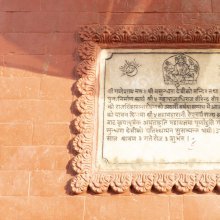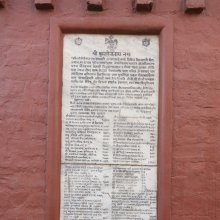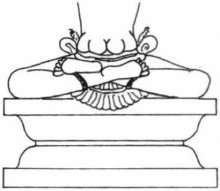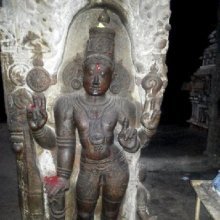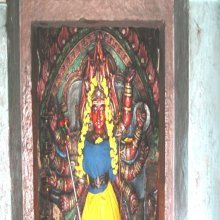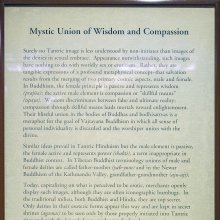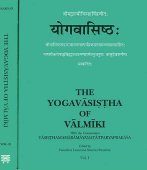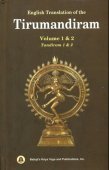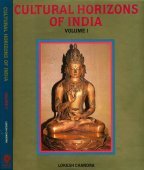Agama, Āgama: 52 definitions
Introduction:
Agama means something in Buddhism, Pali, Hinduism, Sanskrit, Jainism, Prakrit, the history of ancient India, Marathi, Hindi. If you want to know the exact meaning, history, etymology or English translation of this term then check out the descriptions on this page. Add your comment or reference to a book if you want to contribute to this summary article.
Alternative spellings of this word include Aagam.
Images (photo gallery)
(+2 more images available)
In Hinduism
Shaivism (Shaiva philosophy)
Source: Wikipedia: ShaivismThe Shaiva Agama perceives its texts were generated from Shiva as:—From Shiva to Devi, from Devi to Nandhi, from Nandhi to Brahma, from Brahma to Rishi and from Rishi to human beings.
Source: Agama Academy: Kamika AgamaThe Agamas represent on independent class of writing by very early seers, who had an inward experience and enlightenment from the Supreme Being, and who were also perhaps influenced by the Vedas in their original form. They had realized in their lives and thoughts the general truths taught by the early Upanisads. So far as Saivism is concerned, these seers were not men from the North. They were essentially representatives of All India and they reflected in their thoughts, modes of meditation and worship, and in their writing, the inherent Theism of the South.
The Agamas claim Vedic authority for their doctrines. The agama doctrines are indeed theistic and such theism is not foreign to the Upanisads.
Source: McGill: The architectural theory of the Mānasāra (shaivism)Āgama (आगम).—Revelation and sacred scripture in Tamil Śaivism was not, however, limited to the hymns of saints. The Āgamas, texts in Sanskrit that were concerned primarily with sādhana, ritual and spiritual practice, were also considered part of the body of revealed scripture. The contents of the Āgamas generally had a four-fold pada, division or structure: 1) jṅāna, knowledge; 2) yoga, techniques of meditation; 3) kriyā, architectural and iconographie making, and associated rituals; and 4) carya, performance of daily worship, as well as code of religious conduct. Śaiva Siddhānta was the philosophico-theological systematization of Śaiva revelation received through these two streams, and was indelibly linked to the public institution of the temple.
Source: DSpace at Pondicherry: Siddha Cult in Tamilnadu (shaivism)Āgama (आगम).—The āgamas are the basic scriptures of both Southern and Kaśmir Śaivism. Āgama means the source from which the spiritual knowledge spreads in all directions. It has seven characteristics such as creation of the universe, dissolution of the universe, worship of gods and goddesses, spiritual practice, repetition of the mantras for attaining perfection, and performance of satkarma. According to tradition, they are considered to be divinely inspired and emanating from Śiva.
According to one tradition, the basic Śaiva Āgamas are eighteen in number and according to another it is twenty eight.
Source: Shodhganga: Temple management in the ĀgamasĀgama (आगम).—The āgamas are said to have originated from the five faces of Śiva. At the time of creation, Maheśa emanated the āgamas from his five faces in order to establish the four Puruṣārthas (dharma, artha, kāma, mokṣa) in the world. Śaivāgama-lekha-sarvasvam recounts a declaration by Śiva that he uttered both the Veda and Āgama even before the creation of the world.
Source: academia.edu: Religious Inclusivism in the Writings of an Early Modern Sanskrit Intellectual (Shaivism)Āgama (आगम) refers to “religious scripture”.—In his Īśvarapratyabhijñāvimarśinī, Abhinavagupta understands scriptures in such a way that all scriptures, even those of the Buddhists and Jains, possess validity in their own sphere. He broadly defines religious scripture (āgama) as a verbal designation (śabdanarūpa) consisting in the extremely firm (draḍhīyastama) reflective awareness (vimarśa) that occurs within an individual knower. In other words, any group of words that can assist a person in coming to some kind of awareness within himself is an Āgama.
Source: Brill: Śaivism and the Tantric Traditions (philosophy)Āgama (आगम) refers to the “Śaiva non-dualistic scriptures”, according to the Īśvarapratyabhijñāvivṛtivimarśinī.—Accordingly, “The highest level [of reality], although it is concealed to the highest point within the [Śaiva nondualistic] scriptures (āgama), is absolutely never unmanifest; rather, it is always [in the process of] manifesting [itself]—this is the gist [of Utpaladeva’s answer]. And [Utpaladeva] has explained this in the verse on [the Self being] always already established”.

Shaiva (शैव, śaiva) or Shaivism (śaivism) represents a tradition of Hinduism worshiping Shiva as the supreme being. Closely related to Shaktism, Shaiva literature includes a range of scriptures, including Tantras, while the root of this tradition may be traced back to the ancient Vedas.
Purana and Itihasa (epic history)
Source: archive.org: Shiva Purana - English TranslationĀgama (आगम) or Āgamamantra is the name of a mantra that is chanted during Dhārāpūjā, according to the Śivapurāṇa 2.1.14:—“ after performing the regular worship of Śiva, with great devotion in accordance with prescribed rules, the devotees shall pour water in a continuous stream (jaladhārā). This Dhārā worship [viz., Dhārāpūjā] is very efficacious in delirium due to fever (jvarapralāpa). At that time [...] Āgama-mantra, [... etc.,] shall be repeated. The Dhārā worship [viz., Dhārāpūjā] is very excellent in regard to flourishing series of pleasures. [...]”.
Source: Cologne Digital Sanskrit Dictionaries: The Purana IndexĀgama (आगम).—1 —the rules of;2 for digging wells, constructing tanks and gardens;3 cited for yajñas where paśu was not involved and where bīja (seeds) served the purpose of the animal.4
- 1) Viṣṇu-purāṇa I. 17. 58.
- 2) Brahmāṇḍa-purāṇa II. 30. 19 and 27; III. 21. 46.
- 3) Matsya-purāṇa 58. 55; 143. 13.
- 4) Vāyu-purāṇa 53. 122; 57. 100.

The Purana (पुराण, purāṇas) refers to Sanskrit literature preserving ancient India’s vast cultural history, including historical legends, religious ceremonies, various arts and sciences. The eighteen mahapuranas total over 400,000 shlokas (metrical couplets) and date to at least several centuries BCE.
Shaktism (Shakta philosophy)
Source: Google Books: ManthanabhairavatantramĀgama (आगम) refers to “entry”, according to the Manthānabhairavatantra, a vast sprawling work that belongs to a corpus of Tantric texts concerned with the worship of the goddess Kubjikā.—Accordingly, “[...] (Thus the yogi experiences) the contentment (tṛpti) of the night of the Full Moon, which arises in this way laden with nectar. This is the consecration of the Command, the entry (āgama) (of the breath that takes place) in the phase of emanation. Once he has purified (himself) by (this process of) entry and exit (gamāgama), (the adept) should worship the Transmission (kramārcana). [...]”.—(Cf. Mālinīstava)
Source: WikiPedia: ShaktismThe Shakta Agamas or Shakta tantras are 64 in number and grouped into Dakshina marga (right-hand) and Vama marga (left-hand).
Source: Shodhganga: Kasyapa Samhita—Text on Visha Chikitsa (shakta)Āgama (आगम) or Āgamaśāstra refers to the Tantras (“the ancient Indian philosophy that combines Mantras and Yantras”).—The Kulārṇava Tantra mentions that each yuga or age has its scripture. The Satya-yuga had the Vedas. The Treta-yuga had the Smṛtis. The Dvāpara-yuga had the Puraṇas to educate people about the Vedic doctrines in the garb of myths and tales. The Kali-yuga, has the Tantra or Āgama-śāstra.

Shakta (शाक्त, śākta) or Shaktism (śāktism) represents a tradition of Hinduism where the Goddess (Devi) is revered and worshipped. Shakta literature includes a range of scriptures, including various Agamas and Tantras, although its roots may be traced back to the Vedas.
Vaishnavism (Vaishava dharma)
Source: Wikipedia: Vaishnava dharmaThe Vaishnava Agamas are found into two main schools -- Pancharatra and Vaikhanasas.

Vaishnava (वैष्णव, vaiṣṇava) or vaishnavism (vaiṣṇavism) represents a tradition of Hinduism worshipping Vishnu as the supreme Lord. Similar to the Shaktism and Shaivism traditions, Vaishnavism also developed as an individual movement, famous for its exposition of the dashavatara (‘ten avatars of Vishnu’).
Vyakarana (Sanskrit grammar)
Source: Wikisource: A dictionary of Sanskrit grammarĀgama (आगम).—Augment, accrement, a word element which is added to the primitive or basic word during the process of the formation of a complete word or pada. The āgama is an adventitious word element and hence differs from ādeśa, the substitute which wholly takes the place of the original or (आदेशिन् (ādeśin)). Out of the several āgamas mentioned by Pāṇini, those that are marked with mute ट् (ṭ) are prefixed, those, marked with क् (k), are affixed, while those, marked with म् (m), are placed immediately after the last vowel of the word. The augments become a part and parcel of the word to which they are added, and the characteristics of which they possess;cf.यदागमास्तद्गुणी-भूतास्तद्ग्रहणेन गृह्यन्ते (yadāgamāstadguṇī-bhūtāstadgrahaṇena gṛhyante), also आगमानां आगमि-धर्मिवैशिष्ट्यम् (āgamānāṃ āgami-dharmivaiśiṣṭyam) Par. Śek. Pari.11. Those grammarians, who hold the view that words are unproduced and eternal, explain the addition of an augment as only the substitution of a word with an augment in the place of a word without an augment; cf. आदेशास्तर्हिमे भविष्यन्ति अनाग-मकानां सागमकाः (ādeśāstarhime bhaviṣyanti anāga-makānāṃ sāgamakāḥ) M. Bh. on I.1.20; I.1.46. The term āgama is defined as अन्यत्र विद्यमानस्तु यो वर्णः श्रुयतेधिकः । आगम्यमानतुल्यत्वात्स आगम इति स्मृतः (anyatra vidyamānastu yo varṇaḥ śruyatedhikaḥ | āgamyamānatulyatvātsa āgama iti smṛtaḥ) Com. on Tait. Prāt.I. 23.

Vyakarana (व्याकरण, vyākaraṇa) refers to Sanskrit grammar and represents one of the six additional sciences (vedanga) to be studied along with the Vedas. Vyakarana concerns itself with the rules of Sanskrit grammar and linguistic analysis in order to establish the correct context of words and sentences.
Ayurveda (science of life)
Nighantu (Synonyms and Characteristics of Drugs and technical terms)
Source: Wisdom Library: Raj NighantuAgama (अगम) refers to a “tree”, as mentioned in a list of twenty-five synonyms in the second chapter (dharaṇyādi-varga) of the 13th-century Raj Nighantu or Rājanighaṇṭu (an Ayurvedic encyclopedia). The Dharaṇyādi-varga covers the lands, soil, mountains, jungles and vegetation’s relations between trees [viz., Agama] and plants and substances, with their various kinds.
Unclassified Ayurveda definitions
Source: gurumukhi.ru: Ayurveda glossary of termsĀgama (आगम):—Time tested expert opinions in concerned classical texts or authoritative testimony

Āyurveda (आयुर्वेद, ayurveda) is a branch of Indian science dealing with medicine, herbalism, taxology, anatomy, surgery, alchemy and related topics. Traditional practice of Āyurveda in ancient India dates back to at least the first millenium BC. Literature is commonly written in Sanskrit using various poetic metres.
Nirukta (Sanskrit etymology)
Source: Shodhganga: Temple management in the Āgamas (nirukta)Āgama (आगम) is also popularly explained as a compound of āgatam + gatam + matam, meaning that which came from the face of Śiva, was received by Girijā and which serves as the code for śivabhaktas (cf. Introduction to Kāraṇāgama).
Source: Shodhganga: Kasyapa Samhita—Text on Visha Chikitsa (nirukta)Āgama (आगम) is so called because it assists to get to know from the root ‘gamir-gatau’ (to go) or āgama (to come). Roots or dhātus which have ‘gatyartha’ also mean ‘jñāna’—to know. It may also mean that which moves (notionally) towards an object to be attained or accomplished. The preposition ‘ā’ could also mean knowledge that is handed down from guru to śiṣya—i.e., traditional knowledge. Vācaspati Miśra explains the term Āgama as ‘āsamantāt gamatīti āgamaḥ’. Often, the words Āgama and Nigama are used together (Cf. Śāṇḍilya Saṃhitā, 4.16.53).
Nirukta (निरुक्त) or “etymology” refers to the linguistic analysis of the Sanskrit language. This branch studies the interpretation of common and ancient words and explains them in their proper context. Nirukta is one of the six additional sciences (vedanga) to be studied along with the Vedas.
Nyaya (school of philosophy)
Source: academia.edu: Religious Inclusivism in the Writings of an Early Modern Sanskrit Intellectual (nyaya)Āgama (आगम) refers to “scriptures”, according to Jayanta Bhaṭṭa (ninth–tenth century), the great Naiyāyika from Kashmir, who was a close reader of Kumārila’s work.—In his Nyāyamañjarī, Jayanta distinguishes between two types of scriptures (āgama): those that fully contradict the Veda (vedavirodha), and those that teach rites in accordance with the Veda. He includes the teachings of the Buddha in the first category and those of the Śaivas, Pāñcarātrikas, and others, in the second; only those of the second category are ascribed authority. Thus Jayanta extends the application of the vedamūlatva principle to traditions or scriptures that do not explicitly contradict the Veda.
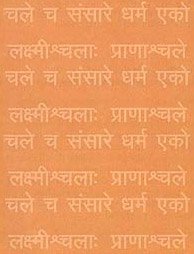
Nyaya (न्याय, nyaya) refers to a school of Hindu philosophy (astika), drawing its subject-matter from the Upanishads. The Nyaya philosophy is known for its theories on logic, methodology and epistemology, however, it is closely related with Vaisheshika in terms of metaphysics.
Yoga (school of philosophy)
Source: ORA: Amanaska (king of all yogas): A Critical Edition and Annotated Translation by Jason Birch1) Āgama (आगम) refers to “studying the Tantras”, according to the Amanaska Yoga treatise dealing with meditation, absorption, yogic powers and liberation.—Accordingly, as Īśvara says to Vāmadeva: “[...] Putting on ochre garments, carrying a skull, plucking out clumps of hair, maintaining non-vedic religious observances, ashes, ascetic clothing and matted locks, behaving as if mad, [the ascetic practice of] nakedness, [studying] the Vedas, Tantras (nigama-āgama) and so on and the meeting [of learned people] for [reciting] poetry in the assembly: All [this] is exertion for the sake of filling one's stomach and is not the cause of the highest good. [...]”.
2) Āgama (आगम) refers to the “coming (of the Ages)”, according to the Mokṣopāya.—Accordingly: “[He is] known as Bhuśuṇḍa [because] his long life is known throughout the world. He is strong-minded because he has seen the coming (āgama) and going of the Ages [of the world], and he is exhausted counting the successions of cycles in each cosmic period”.

Yoga is originally considered a branch of Hindu philosophy (astika), but both ancient and modern Yoga combine the physical, mental and spiritual. Yoga teaches various physical techniques also known as āsanas (postures), used for various purposes (eg., meditation, contemplation, relaxation).
General definition (in Hinduism)
Source: Hindupedia: The Hindu EncyclopediaAgamas expound many aspects, including personal worship, temple construction and architecture, Iconography, worship in temple, Vāstu and so on. It is not an exaggeration to say that most of the popular aspects of Hinduism are found in Purānic and Agamic literature. Primarily Agamas are of three schools – Vaiṣṇava, Śaiva and Śāktā. They are followed by Vaiṣṇavites, Śaivaites and Śāktās respectively.
Agama has three parts, Mantra, Tantra and Yantra.
Source: Institute of Sri Ramchandra Consciousness: A Handbook of Hindu Religion: LiteratureĀgama (आगम):—The Āgamas contain rules for the construction of temples and shaping of arcas and the consecration and worship of the latter. The Āgamas are treatises by sages on the practical side of religion. They contain rules for the construction of the temples, making of arca, consecration of the temples and idols, worship of the arca and expiatory ceremonies for acts of commission and omission. Incidentally they treat of town planning to show the place of temple in a planned town and the qualifications of the worshipper. These Āgamas are two-fold, the Vaiṣṇava and the Śaiva according as they treat of the temples, arca and worship of the different forms of Viṣṇu or Śiva.
Each Āgama has four sections in it called
- Caryā,
- Kriyā,
-
Yoga
- and Jñāna.
The first treats of the daily duties; the second of the worship of God; the third of the practices tending to the control of the senses and for the meditation of God. The last treats of the nature of God, the constitution of the body and mukti.
Source: DSpace at Pondicherry: Siddha Cult in Tamilnadu (hinduism)Āgama (आगम).—According to the Vārāhītantra, Āgama deals with seven topics, viz., cosmology, destruction, worship of god, sādhanā, puraścarṇa, six forms of rites and four forms of meditation. The number of Āgamas of the Pañcarātra School is generally stated to be 108, but on comparison with different lists their number appears to be more than Two hundred. The Vārāhītantra gives a list of twelve special Āgamas which are Muktaka, Prapañca, Śāradā, Nārada, Mahārnava, Kapila, Yōga, Kalpa, Kapiñjala, Amrtaśuddhi, Vīra and Siddhasamvaraṇa.
The Āgamas are of three main classes’ viz., Śaivāgama, Śaktāgama and Vaiṣṇavāgama or Pañcarātra. Each and every sect also have their own Āgamas.
The Āgamas are usually in verse, and vary in length. In theory they consist of four parts (pādas):
- on knowledge or doctrine (vidyāpāda),
- on ritual (kriyāpāda),
- on conduct (caryāpāda),
- and on yoga (yōgapāda);
Āgamas do not focus on philosophy or doctrine; but on how devotees should conduct their lives and practice religion. The doctrine in all Āgamas is not homogeneous; some are dualist, others non-dualist. Their cosmogony (notably the lists of tattvas) also differs, as do their views on initiation.
Source: Shodhganga: Iconographical representations of Śiva (h)Āgama (आगम) is generally defined as “well constructed and traditionally communicated wisdom”, i.e ā + gam. Āgamas are broadly classified into three groups viz. Śaiva, Vaiṣṇava and Śākta. Based on this sectarian classifications definitions are different from each other. These Āgamas are also often employed as synonyms with the words called Tantra, Mahātantra and Saṃhitā.
The Śaivāgamas represent the wisdom that has come down from lord Śiva, received by Pārvatī and accepted by Viṣṇu so, it is termed as Āgama. Or, it represents the wisdom proceeded from the mouth of Śiva, received by Pārvatī, which is capable of removing three impurities are called as Āgamas. The Śāktāgamas holds the idea that of holy wisdom imparted by Devī to Īśvara. This is in consonance with Śaivāgamas. The Vaiṣṇavāgamas preache us the right behaviour, knowledge about the divine states and manner of obtaining them, and about the glory of God and reality (definitions found in this school treat āgama as a śāstra).
Source: Shodhganga: Kasyapa Samhita—Text on Visha Chikitsa (h)Āgama (आगम) refers to “those texts which clearly give mankind the guidelines and means to lead a fruitful, progressive and meaningful life”, according to Vācaspati Miśra.—The Āgamas are thus, a veritable mine which were revealed by the Almighty and they give us deep insights into the Agamic principles. While the Vedas are considered as the breath of the Almighty (niśvāsa-rūpa), the Āgamas are His words (vāg-rūpa).
Āgamas are basically of three kind—
- Śaiva-āgama,
- Śākta-āgama and
- Vaiṣṇava-āgama.
All Āgamas are generally divided into four sections:
- Jñāna–the knowledge leading to Ultimate reality;
- Yoga–different modes of worship of the Supreme;
- Caryā–temple building, sculpture, iconography and so on; and
- Kriyā–nitya-naimittika (daily and occasional) rituals in temples, the various utsavas, pūjā vidhi, dīkṣā and so on.
The Āgamas are the very essence of all the Śāstras that assists an aspirant in understanding all that is taught by them, both theory and practice. The Āgamas that enriched the Vedic rituals in a simple and elegant style, have added Yoga and Bhakti to worship, supplemented the existing mantras with ślokas and tailored worship into an easily comprehensible way so as to cater to the needs and capacity of the present generation which is steeped in the materialistic world and its attendant chores and chaos. Thus, the Vedic yajñas have been replaced by apparently simple rituals of temple worship, based on the Āgamas. Āgama is also known variously as Tantra and Saṃhitā.
In Buddhism
Mahayana (major branch of Buddhism)
Source: Wisdom Library: Maha Prajnaparamita SastraĀgama (आगम) refers to “coming” (Cf. Nirgama—‘going’), according to Mahāprajñāpāramitāśāstra (chapter 41).—Accordingly, “[The eighteen āveṇika-dharmas (‘special attributes’)]—[...] (5). The Buddha has no non-concentrated mind.—[...] All the characteristics of things (dharmalakṣaṇa), unity (ekārtha), multiplicity (nānārtha), production (utpāda), cessation (nirodha), interruption (uccheda), permanence (śāśvata), coming (āgama) and going (nirgama) are deceptions, the formation of a collection of falsehoods. Since the Buddha is well established in the true nature of dharmas, his mind is never non-concentrated and, being never non-concentrated, it does not change. [...]”.

Mahayana (महायान, mahāyāna) is a major branch of Buddhism focusing on the path of a Bodhisattva (spiritual aspirants/ enlightened beings). Extant literature is vast and primarely composed in the Sanskrit language. There are many sūtras of which some of the earliest are the various Prajñāpāramitā sūtras.
General definition (in Buddhism)
Source: WikiPedia: BuddhismĀgama () in Buddhism is used to refer to a collection of discourses (Sanskrit: sutra; Pali: sutta) of the early Buddhist schools, which were preserved primarily in Chinese translation, with substantial material also surviving in Sanskrit and lesser but still significant amounts surviving in Gāndhārī and in Tibetan translation.
There are four extant collections of āgamas, and one for which we have only references and fragments (the kṣudrakāgama). The four extant collections are preserved in their entirety only in Chinese translation (āgama: 阿含經), although small portions of all four have recently been discovered in Sanskrit, and portions of four of the five āgamas are preserved in Tibetan.
The four (plus one) āgamas are:
- The dīrgha-āgama (“long discourses”, Cháng Ahánjīng 長阿含經 Taishō) corresponds to the Dīgha-nikāya of the Theravada school.
- The madhyama-āgama (“middle-length discourses”, Zhōng Ahánjīng 中阿含經, Taishō 26) corresponds to the Majjhima-nikāya of the Theravada school.
- The saṃyukta-āgama (“connected discourses”, Zá Ahánjīng 雜阿含經 Taishō 2.99) corresponds to the Saṃyutta-nikāya of the Theravada school.
- The ekottara-āgama (“numbered discourses”, Zēngyī Ahánjīng, 增壹阿含經 Taishō 125) corresponds to the Anguttara-nikāya of the Theravada school.
- The kṣudraka-āgama or the kṣudraka-piṭaka (“minor collection”) corresponds to the Khuddaka-nikāya, and existed in some schools (e.g., Dharmaguptaka).
In Jainism
Jain philosophy
Source: archive.org: Anekanta Jaya Pataka of Haribhadra SuriĀgama (आगम) refers to the “Jaina canon”, as mentioned in the Anekāntajayapatākā-prakaraṇa, a Śvetāmbara Jain philosophical work written by Haribhadra Sūri.—[Cf. Vol. II, P. 219, l. 23]
-
General definition (in Jainism)
Source: archive.org: TrisastisalakapurusacaritraĀgama (आगम) refers to the “canon of scriptures”, according to chapter 2.2 [ajitanātha-caritra] of Hemacandra’s 11th century Triṣaṣṭiśalākāpuruṣacaritra: an ancient Sanskrit epic poem narrating the history and legends of sixty-three illustrious persons in Jainism.
Accordingly: “[...] Ājñā is the teaching of the Arhats, and it is established as two-fold; of these the first is āgama and the second hetuvāda. Āgama is that which gives knowledge from the words only of the categories. Hetuvāda is named from conformity with another authority. There is equal authority of these two from agreement because of the characterization of ‘authority’ as ‘originating from a source free from any fault’. [...]”.
Source: The University of Sydney: A study of the Twelve ReflectionsAgama (अगम) refers to the “rising (of the sun)”, according to the 11th century Jñānārṇava, a treatise on Jain Yoga in roughly 2200 Sanskrit verses composed by Śubhacandra.—Accordingly, “Sentient beings, inflamed by very intense pleasure [and] unsteady from affliction by wrong faith, wander about in a five-fold life that is difficult to be traversed. It has been stated at length that the cycle of rebirth which is full of suffering is five-fold on account of combining substance , place, right time [com.—time (kālaḥ) is characterised by the progressive half of the cycle of time, etc. (utsarpiṇyādilakṣaṇaḥ) or indicated by the setting and rising of the sun, etc. (sūryagamāgamādivyaṅgyaḥ)], life and intention”.
Source: SOAS Research Online: Prekṣā meditation: History and MethodsAgama (अगम) or “ inaccessible” refers to one of the 46 qualities of the soul to be meditated on in the “Practice of Meditation on Liberated Souls (Siddhas)”, according to Jain texts like Ācārāṅga (5.6.123-140), Ṣaṭkhaṇḍāgama (13.5.4.31) and Samayasāra (1.49).—The pure soul can be recognised by meditation on its true nature, represented by the liberated souls of the Siddhas. The practice which leads to this realisation is meditation on the fact that attachment, aversion, passions and the influx of karmas, are ‘not mine’, that I am separate from them and consist of infinite knowledge, perception, conduct, spiritual energy, that I am the pure, enlightened, and everlasting soul. The qualities of the soul to be meditated on as truly mine are: [e.g., My soul is inaccessible (agama)] [...] The meditation on such extended fourty-five qualities of the pure soul presents the niśacaya-naya, which is aligned with Kundakunda’s approach.

Jainism is an Indian religion of Dharma whose doctrine revolves around harmlessness (ahimsa) towards every living being. The two major branches (Digambara and Svetambara) of Jainism stimulate self-control (or, shramana, ‘self-reliance’) and spiritual development through a path of peace for the soul to progess to the ultimate goal.
India history and geography
Source: Cologne Digital Sanskrit Dictionaries: Indian Epigraphical GlossaryĀgama.—(SII 1), a doctrine; cf. Lākul-āgama (EI 32), the doctrine of Lakula (Lakulīśa). Cf. āgama-samaya. Cf. s-āgama-nirgama-praveśa (IE 8-5), ‘together with approaches, ingress and egress’. Note: āgama is defined in the “Indian epigraphical glossary” as it can be found on ancient inscriptions commonly written in Sanskrit, Prakrit or Dravidian languages.

The history of India traces the identification of countries, villages, towns and other regions of India, as well as mythology, zoology, royal dynasties, rulers, tribes, local festivities and traditions and regional languages. Ancient India enjoyed religious freedom and encourages the path of Dharma, a concept common to Buddhism, Hinduism, and Jainism.
Languages of India and abroad
Pali-English dictionary
Source: BuddhaSasana: Concise Pali-English Dictionaryāgama : (m.) 1. coming; approach; 2. religion; scripture; 3. an inserted consonant.
Source: Sutta: The Pali Text Society's Pali-English DictionaryĀgama, (fr. ā + gam) — 1. coming, approach, result, D.I, 53 (āgamanaṃ pavattatī ti DA.I, 160; cp. Sdhp.249 dukkh°). — 2. that which one goes by, resource, reference, source of reference, text, Scripture, Canon; thus a designation of(?) the Pātimokkha, Vin.II, 95 = 249, or of the Four Nikāyas, DA.I, 1, 2 (dīgh°). A def. at Vism.442 runs “antamaso opamma-vagga-mattassa pi buddhavacanassa pariyāpuṇaṇaṃ”. See also āgata 2, for phrase āgat’āgama, handed down in the Canon, Vin Loc. cit. Svāgamo, versed in the doctrine, Pv IV.133 (sv° = suṭṭhu āgat’āgamo, PvA.230); Miln.215. BSk. in same use and meaning, e. g. Divy 17, 333, āgamāni = the Four Nikāyas. — 3. rule, practice, discipline, obedience, Sn.834 (āgamā parivitakkaṃ), cp. Davs.V, 22 (takk°, discipline of right thought) Sdhp.224 (āgamato, in obedience to). ‹-› 4. meaning, understanding, KhA 107 (vaṇṇ°). — 5. repayment (of a debt) J. VI, 245. — 6. as gram. tt. “augment”, a consonant or syllable added or inserted SnA 23 (sa-kār’āgama). (Page 95)

Pali is the language of the Tipiṭaka, which is the sacred canon of Theravāda Buddhism and contains much of the Buddha’s speech. Closeley related to Sanskrit, both languages are used interchangeably between religions.
Marathi-English dictionary
Source: DDSA: The Molesworth Marathi and English Dictionaryāgama (आगम).—m (S) A general name for a Shastra or work on science and of divine origin. 2 A class of Shastras, containing spells and incantations. 3 Rise, origin, the reaching or falling unto (as of an estate) considered as constituting the claim or title to it. () 4 Beginning, commencement, outset. Pr. pātaka āgamīṃ gōḍa nirgamīṃ kaḍū. Also āgamē sukhamāprōti nirgamē prāṇasaṅkaṭaṃ. 5 Approach, arrival, coming to. 6 A title-deed; any voucher, record, or document, constituting a legal title. 7 A grammatical augment.
--- OR ---
āgama (आगम).—. Add:--8 Rise, spring, origin, coming into being.
Source: DDSA: The Aryabhusan school dictionary, Marathi-Englishāgama (आगम).—m Rise. Approach. Beginning. A title-deed. A class of Shastras.
Marathi is an Indo-European language having over 70 million native speakers people in (predominantly) Maharashtra India. Marathi, like many other Indo-Aryan languages, evolved from early forms of Prakrit, which itself is a subset of Sanskrit, one of the most ancient languages of the world.
Sanskrit dictionary
Source: DDSA: The practical Sanskrit-English dictionaryAgama (अगम).—a = अग (aga) q. v. बभूवुरगमाः सर्वे मारुतेन विनिर्धुताः (babhūvuragamāḥ sarve mārutena vinirdhutāḥ) Rām.5.14.17.
--- OR ---
Āgama (आगम).—1 Coming, arrival, approach, appearance; लतायां पूर्वलूनायां प्रसूनस्यागमः कुतः (latāyāṃ pūrvalūnāyāṃ prasūnasyāgamaḥ kutaḥ) Uttararāmacarita 5.2; Śiśupālavadha 1.3; अव्यक्ताद् व्यक्तयः सर्वाः प्रभवन्त्यहरागमे । रात्र्यागमे प्रलीयन्ते (avyaktād vyaktayaḥ sarvāḥ prabhavantyaharāgame | rātryāgame pralīyante) Bhagavadgītā (Bombay) 8. 18; R.14.8, Pañcatantra (Bombay) 3.48; Manusmṛti 8.41; so व्यसन°, अन्धकार° (vyasana°, andhakāra°) &c.
2) Acquisition; एषोऽ स्या मुद्राया आगमः (eṣo' syā mudrāyā āgamaḥ) Mu.1; Ś.6. this is how I came by this ring; Daśakumāracarita 139; वेदानामागमः (vedānāmāgamaḥ) K.18; विद्यागमनिमित्तम् (vidyāgamanimittam) V.5.
3) Birth, origin, source; आगमापायिनोऽनित्यास्तांस्तितिक्षस्व भारत (āgamāpāyino'nityāstāṃstitikṣasva bhārata) Bhagavadgītā (Bombay) 2.14 coming and going, of short birth or duration, transient; आगमः काव्यामृतरसानाम् (āgamaḥ kāvyāmṛtarasānām) K.5.
4) Addition, accumulation, acquisition (of wealth); अर्थ°, धन° (artha°, dhana°) &c.
5) Flow, course, current (of water); Manusmṛti 8.252,9.281; रक्त°, फेण° (rakta°, pheṇa°).
6) A voucher or written testimony; see अनागम (anāgama). संभोगो दृश्यते यत्र न दृश्येतागमः क्वचित् (saṃbhogo dṛśyate yatra na dṛśyetāgamaḥ kvacit) Manusmṛti 8.2.
7) Knowledge; शिष्यप्रदेयागमाः (śiṣyapradeyāgamāḥ) Bhartṛhari 2.15; प्रज्ञया सदृशागमः । आगमः सदृशारम्भः (prajñayā sadṛśāgamaḥ | āgamaḥ sadṛśārambhaḥ) R.1.15; यस्यागमः केवलजीविकायै (yasyāgamaḥ kevalajīvikāyai) M.1.17; Y.2.212,92.
8) Supply of money, income, revenue.
9) Lawful acqusition of anything; आगमेपि बलं नैव भुक्तिः स्तोकापि यत्र नो (āgamepi balaṃ naiva bhuktiḥ stokāpi yatra no) Y.2.27,28.
1) Increase of property.
11) A traditional doctrine or precept, a sacred writing or scripture, Śāstra; अनुमानेन न चागमः क्षतः (anumānena na cāgamaḥ kṣataḥ) Kirātārjunīya 2.28,5.18; परिशुद्ध आगमः (pariśuddha āgamaḥ) 2.33; K.55,337.
12) The study of Śāstras, sacred knowledge or learning.
13) Science, a system of philosophy; साङ्ख्यागमेनेव प्रधानपुरुषोपेतेन (sāṅkhyāgameneva pradhānapuruṣopetena) K.51; बहुधाप्यागमैर्भिन्नाः पन्थानः सिद्धिहेतवः (bahudhāpyāgamairbhinnāḥ panthānaḥ siddhihetavaḥ) R.1.26
14) the Vedas, the sacred scripture; आत्मन्युपरते सम्यङ् मुनिर्व्युपरतागम (ātmanyuparate samyaṅ munirvyuparatāgama) Bhāgavata 1.2.4. न्यायनिर्णीतसारत्वा- न्निरपेक्षमिवारामे (nyāyanirṇītasāratvā- nnirapekṣamivārāme) Kirātārjunīya 11.39.; आगमः खल्पपि (āgamaḥ khalpapi) Mahābhārata on P.I.1.1.
15) The last of the four kinds of proof, recognized by the Naiyāyikas (also called śabda or āpta- vākya, the Vedas being so regarded).
16) An affix or suffix.
17) The addition or insertion of a letter; भवेद्- वर्णागमाद्धंसः (bhaved- varṇāgamāddhaṃsaḥ) Sk.
18) An augment; इडागमः (iḍāgamaḥ).
19) Theory (opp. prayoga); चतुःषष्टिकलागमप्रयोगचतुरः (catuḥṣaṣṭikalāgamaprayogacaturaḥ) Daśakumāracarita 12.
2) (-maḥ, -mam) A work inculcating the mystical worship of शिव (śiva) and शक्ति (śakti), a Tantra; आगतं पञ्चवक्त्रात्तु गतं च गिरिजानने । मतं च वासुदेवस्य तस्मादागममुच्यते (āgataṃ pañcavaktrāttu gataṃ ca girijānane | mataṃ ca vāsudevasya tasmādāgamamucyate) || Śabdak.
12) The mouth of a river.
22) What comes later or afterwards. आगमवदन्त्यलोपः स्यात् (āgamavadantyalopaḥ syāt) MS.1.5.1. (āgamavat as explained by śabara is yathā samājeṣu samāseṣu caṃ ye āgantavo bhavanti te pūrvopaviṣṭānanupamṛdyaiva niviśante evamihāpi draṣṭavyam |
23) A way of worship; labdhānugraha ācāryāttena sandarśitā- gamaḥ | mahāpuruṣamabhyarcenmūrtyābhimatamātmanaḥ || Bhāgavata 11.3.48.
24) A road or way journey; āgamāste śivāḥ santu Rām.2.25.21.
Derivable forms: āgamaḥ (आगमः).
Source: Cologne Digital Sanskrit Dictionaries: Edgerton Buddhist Hybrid Sanskrit DictionaryĀgama (आगम).—(1) m. (= Sanskrit, as general term), traditional or canonical text; especially applied to the four collections called in Pali nikāya, see Ekottarika, Dīrghāgama, Madhya- māgama, Saṃyuktāgama; (2) in āgama-vastu Mahāvastu i.318.7, meaning obscure; see vastu.
Source: Cologne Digital Sanskrit Dictionaries: Shabda-Sagara Sanskrit-English DictionaryAgama (अगम).—m.
(-maḥ) 1. A tree. 2. A mountain. E. a priv. and gama who goes.
--- OR ---
Agama (अगम).—m.
(-maḥ) A Brahman, one who does not salute a Brahman making obeisance to the gods only, and returning salutations, with his blessing. E. a neg. and gama who salutes.
--- OR ---
Āgama (आगम).—m.
(-maḥ) 1. Arrival, coming, approach. 2. A Sastra or work on sacred science in general, supposed to be of divine origin. 3. A Tantra or any work inculcating the mystical worship of Siva and Sakti. 4. A grammatical augment, a syllable or letter inserted in any part of the radical word. 5. Record, title deed, legal title, a voucher or written testimony, &c. E. āṅ before gam to go, to come, ac aff.
Source: Cologne Digital Sanskrit Dictionaries: Benfey Sanskrit-English DictionaryĀgama (आगम).—[ā-gam + a], m. 1. Arrival, [Rāmāyaṇa] 2, 25, 19. 2. Occurrence, [Yājñavalkya, (ed. Stenzler.)] 2, 92. 3. Stream, [Mānavadharmaśāstra] 8, 252. 4. Afflux of wealth, [Bhartṛhari, (ed. Bohlen.)] 2, 39. 5. Report, [Yājñavalkya, (ed. Stenzler.)] 2, 212. 6. Knowledge, [Rāmāyaṇa] 6, 4, 30. 7. Art, [Mālavikāgnimitra, (ed. Tullberg.)] 15, [distich] 16. 8. Sacred science, [Kirātārjunīya] 5, 22. 9. A work on sacred science, [Kirātārjunīya] 5, 18. 10. A precept, Mahābhārata 3, 1163. 11. A legal title, [Mānavadharmaśāstra] 8, 202.
--- OR ---
Agama (अगम).—1. adj. inaccessible, Mahābhārata 3, 8247. 2. m. a tree. Durgama, i. e.
Agama is a Sanskrit compound consisting of the terms a and gama (गम).
Source: Cologne Digital Sanskrit Dictionaries: Cappeller Sanskrit-English DictionaryAgama (अगम).—[adjective] immovable, inaccessible; [masculine] tree.
--- OR ---
Āgama (आगम).—[adjective] coming to, approaching, being added. [masculine] approach, arrival, going to (—°); course (of a river), appearance, origin; income, revenue, possession, title; knowl edge, science, doctrine; augment ([grammar]).
Source: Cologne Digital Sanskrit Dictionaries: Aufrecht Catalogus CatalogorumĀgama (आगम) as mentioned in Aufrecht’s Catalogus Catalogorum:—The Kāraṇāgama. Hz. 2 p. 80 enumerates 28: Kāmika, Yogaja, Cintya, Kāraṇa, Ajita, Dīpta, Sūkṣma, Sahasra, Añśumat, Suprabheda, Vijaya, Niśvāsa, Svāyambhuva, Ānala, Vīra, Raurava, Makuṭa, Vimala, Candrajñāna, Bimba, Prodgīta, Lalita, Siddha, Saṃtāna, Śaiva, Pārameśvara, Kiraṇa, Vātula.
Āgama has the following synonyms: Tantra.
Source: Cologne Digital Sanskrit Dictionaries: Monier-Williams Sanskrit-English Dictionary1) Agama (अगम):—[=a-gama] mfn. not going, unable to go
2) [v.s. ...] impassable, [Mahābhārata]
3) [v.s. ...] m. a mountain, [cf. Lexicographers, esp. such as amarasiṃha, halāyudha, hemacandra, etc.]
4) [v.s. ...] a tree (cf. a-ga).
5) Āgama (आगम):—[=ā-gama] [from ā-gam] mf(ā)n. coming near, approaching, [Atharva-veda vi, 81, 2; xix, 35, 3]
6) [v.s. ...] m. (ifc. f(ā). ) arrival, coming, approach, [Rāmāyaṇa] etc.
7) [v.s. ...] m. origin, [Manu-smṛti viii, 401; Rāmāyaṇa] etc.
8) [v.s. ...] appearance or reappearance, [Mahābhārata ii, 547]
9) [v.s. ...] course (of a fluid), issue (e.g. of blood), [Manu-smṛti viii, 252; Suśruta]
10) [v.s. ...] income, lawful acquisition (of property, artha, dhana, vitta, draviṇa), [Manu-smṛti; Mahābhārata] etc.
11) [v.s. ...] reading, studying, [Patañjali]
12) [v.s. ...] acquisition of knowledge, science, [Mahābhārata; Yājñavalkya] etc.
13) [v.s. ...] a traditional doctrine or precept, collection of such doctrines, sacred work, Brāhmaṇa, [Manu-smṛti xii, 105; Mahābhārata] etc.
14) [v.s. ...] anything handed down and fixed by tradition (as the reading of a text or a record, title-deed, etc.)
15) [v.s. ...] addition, [Nirukta, by Yāska i, 4]
16) [v.s. ...] a grammatical augment, a meaningless syllable or letter inserted in any part of the radical word, [Prātiśākhya; Pāṇini] [commentator or commentary]
17) [v.s. ...] Name of a rhetorical figure
18) [v.s. ...] n. a Tantra or work inculcating the mystical worship of Śiva and Śakti.
Source: Cologne Digital Sanskrit Dictionaries: Goldstücker Sanskrit-English DictionaryAgama (अगम):—[tatpurusha compound] m.
(-maḥ) 1) A mountain.
2) A tree. E. a neg. and gama. See also agaccha, aga and naga.
Source: Cologne Digital Sanskrit Dictionaries: Yates Sanskrit-English Dictionary1) Agama (अगम):—[a-gama] (maḥ) 1. m. A tree; a mountain.
2) Āgama (आगम):—[ā-gama] (maḥ) 1. m. Coming; a shāstra on sacred science; grammatical augment, a record.
Source: DDSA: Paia-sadda-mahannavo; a comprehensive Prakrit Hindi dictionary (S)Agama (अगम) in the Sanskrit language is related to the Prakrit words: Agama, Āgama.
[Sanskrit to German]
Sanskrit, also spelled संस्कृतम् (saṃskṛtam), is an ancient language of India commonly seen as the grandmother of the Indo-European language family (even English!). Closely allied with Prakrit and Pali, Sanskrit is more exhaustive in both grammar and terms and has the most extensive collection of literature in the world, greatly surpassing its sister-languages Greek and Latin.
Hindi dictionary
Source: DDSA: A practical Hindi-English dictionary1) Agama (अगम) [Also spelled agam]:—(a) inaccessible, unattainable; incomprehensible; hence ~[tā] (nf).
2) Āgama (आगम) [Also spelled aagam]:—(nm) coming near, approaching; an augment (in grammar); birth, origin; scripture; traditional doctrine or precept; collection of such doctrines; anything handed down and fixed by tradition; induction; proceeds; -[śruti] a tradition.
...
Prakrit-English dictionary
Source: DDSA: Paia-sadda-mahannavo; a comprehensive Prakrit Hindi dictionary1) Agama (अगम) in the Prakrit language is related to the Sanskrit word: Agama.
2) Agama (अगम) also relates to the Sanskrit word: Agama.
3) Āgama (आगम) also relates to the Sanskrit word: Āgam.
4) Āgama (आगम) also relates to the Sanskrit word: Āgama.
5) Āgama (आगम) also relates to the Sanskrit word: Āgama.
6) Āgama (आगम) also relates to the Sanskrit word: Āgam.
Prakrit is an ancient language closely associated with both Pali and Sanskrit. Jain literature is often composed in this language or sub-dialects, such as the Agamas and their commentaries which are written in Ardhamagadhi and Maharashtri Prakrit. The earliest extant texts can be dated to as early as the 4th century BCE although core portions might be older.
Kannada-English dictionary
Source: Alar: Kannada-English corpusAgama (ಅಗಮ):—[adjective] not moving; stationary.
--- OR ---
Agama (ಅಗಮ):—[noun] that which cannot move a) a tree; b) a mountain.
--- OR ---
Āgama (ಆಗಮ):—
1) [noun] the act of coming; arriving; arrival.
2) [noun] a sectarian work which contain mythological, epical and philosophical materials, and is alternative or supplementary to traditional scriptures.
3) [noun] the science or technical details of worshipping or carving the idols.
4) [noun] (gram.) in composition of two words, an instance of inter-positioning of a fresh vowel or consonant.
5) [noun] knowledge.
6) [noun] a letter or certificate given to a person to show that he has a right to confidence or to the exercise of a certain position or authority; credentials.
Kannada is a Dravidian language (as opposed to the Indo-European language family) mainly spoken in the southwestern region of India.
See also (Relevant definitions)
Starts with (+82): A-kamavinai, Aagamanaatmak-samanyikaran, Agama Sutra, Agama-ghiu-thapnu, Agama-nigama-dana, Agama-samaya, Agamabhashe, Agamabhavane, Agamabhedita, Agamacandrika, Agamadike, Agamadipika, Agamaga, Agamago, Agamahnika, Agamajala, Agamajanita, Agamajna, Agamajne, Agamakalpadruma.
Ends with (+508): Abamavipatagama, Abbhagama, Abbhuvagama, Abhavagama, Abhisamagama, Abhisamagama, Abhiyagama, Abhragama, Abhyagama, Abhyupagama, Accagama, Adagama, Adisvaragama, Aganagama, Agatagama, Aghoragama, Ahaagama, Aharagama, Ajagama, Ajitagama.
Full-text (+2476): Agamanirapeksha, Agamas, Agamashastra, Mutalvanvakku, Hara, Mrigayatra, Vama, Vaishnavagama, Akamankal-otinon, Caivakamam, Yathagamam, Amanayam, Shaivagama, Agaccha, Vishvaksenasamhita, Agamashruti, Agamavirodha, Agamasamhita, Cainakamam, Asana.
Relevant text
Search found 156 books and stories containing Agama, A-gama, Ā-gama, Āgama; (plurals include: Agamas, gamas, Āgamas). You can also click to the full overview containing English textual excerpts. Below are direct links for the most relevant articles:
Rig Veda (translation and commentary) (by H. H. Wilson)
Diaspora of Bhuta (Daiva) worshipping cult—India and Indonesia (by Shilpa V. Sonawane)
Part 4 - Agama Hinduism followed by Hindus in Bali Indonesia < [Chapter 4 - Inter-Disciplinary Analysis]
Hari-bhakti-kalpa-latikā (by Sarasvati Thkura)
Manusmriti with the Commentary of Medhatithi (by Ganganatha Jha)
Verse 8.401 < [Section XLVIII - Laws relating to Civic Misdemeanours]
Verse 9.281 < [Section XXXVIII - Treatment of Criminals and their Punishment]
Verse 8.200 < [Section XXXIII - Fraudulent Sale]
Jainism and Patanjali Yoga (Comparative Study) (by Deepak bagadia)
Part 6 - Survey of previous research (Literature Review) < [Chapter 1 - Introduction]
Part 6 - Literature (comparing Yoga and Jainism < [Chapter 4 - A Comparative Study]
Part 5.1 - The main Twelve Angas < [Chapter 3 - Jain Philosophy and Practice]
Related products
